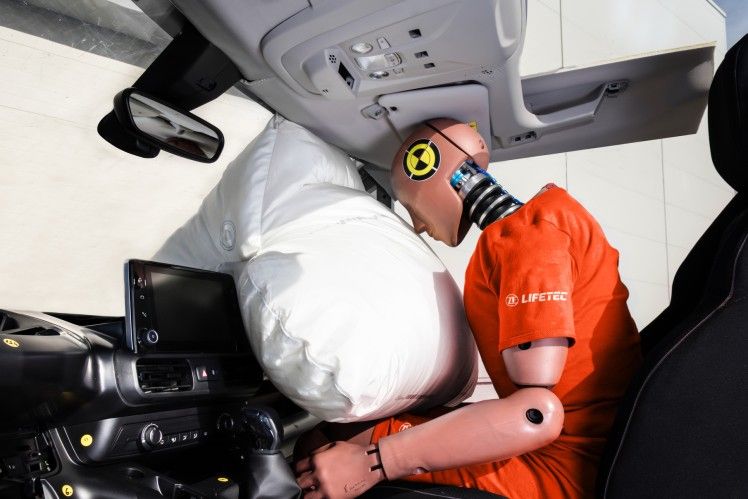Head-on collisions can be dangerous. This even holds true for collisions on the opposite side to the occupant, as the impact can throw the occupant’s body toward the middle of the vehicle. A new airbag from ZF could help prevent injury here.
Modern cars now feature high-level safety measures deployable in the event of an accident. This is because the new vehicle models in many countries now come equipped with driver and passenger airbags as well as side and curtain airbags as standard. The latest results from crash tests demonstrate that occupants involved in a collision on the side of the vehicle opposite to the passenger, referred to as the far side in professional circles, can still be vulnerable.
In certain crash events, the test dummies show that the occupant’s torso could bend over the center console while the seat belt hold the pelvis back in the seat. As a result, the thoracic spine twists and the cervical spine can be overstretched. The dummy data readings indicate that serious injuries could result.
“Far-side safety countermeasures present an untapped area for injury reduction,” summed up the renowned accident investigator Dr. Kennerly Digges at a congress held by the US National Highway Traffic Safety Administration in 2015. Working together with nine additional partners from the fields of science and industry, Digges – a professor at the George Washington University in Ashburn, has carried out a great deal of research on this topic. He was also the initiator of the New Car Assessment Program (NCAP), which grades vehicles by means of crash tests, a star rating and is now the benchmark for vehicle safety in many countries. Likewise in 2015, ZF showcased its far-side airbag concept for the first time. Installed in the inward-facing side of the driver’s seat, the airbag can help to provide better protection to both the driver and front-seat passenger.
The Euro NCAP, the European consumer protection organization for vehicle safety, was the first organization in the world to react to the far-side problem. The test requirements that had been introduced in 2020 expanded the scope of the investigations into head-on collisions on the side of the vehicle opposite to the occupants. A total of 16 points within the Euro NCAP are awarded to head-on collisions; 4 of these points will focus solely on the topic of far-side collisions. A car can achieve a maximum of 38 points in all four categories for the protection of adult occupants. The findings of an American-Australian joint research project have shown that this change is worthwhile. An analysis of accident statistics in both countries revealed that no less than 33 percent of all serious injuries or deaths suffered in head-on collisions were the result of far-side collisions.

The design of the ZF far-side airbag focuses on two chambers that are arranged in a specific way to complement each other. “This special design was developed based on the fact that we want to support the head in the upper area as early as possible. The shoulders of the occupant are usually held in place between the two chambers. The entire upper body is therefore better supported on both sides,” explains Dominique Acker, an engineer involved in the preliminary development of side airbags in the Passive Safety Systems Division. This means that the airbag differs from the front and side airbags: the function of these airbags is to help reduce the body’s momentum by “enveloping” the occupant, while the far-side airbag provides the occupant’s body with more support. “The pressure in the chambers is therefore higher than in most other airbags,” explains Acker.
%
of all serious injuries or deaths suffered in head-on collisions are the result of far-side collisions.The considerably larger far-side airbag is integrated in the driver’s seat in a similar fashion to a side airbag. In the event of a head-on collision, the airbag control unit can trigger the far-side airbag shortly after the standard side airbag. In order to stabilize the far-side airbag, it is either fixed in place on the seat frame with a strap or supported by the center console. It can also be triggered when a collision takes place on the driver’s side. This is due to the fact that if there are people sitting in both of the car’s front seats, lateral acceleration can cause the two car occupants to collide with one another. In this instance, the far-side airbag can help prevent this exact scenario from taking place.
ZF has continuously developed its far-side airbag, and can thus provide car manufacturers with a sophisticated system to meet the Euro NCAP requirements. “We commenced the first series production of the airbag in a compact-class vehicle already in 2020,” explains Dominique Acker. With this development, Acker and his colleagues played and are playing an important role in moving one step closer to achieving ZF’s Vision Zero – a world with zero emissions and zero accidents.

Martin Westerhoff studied technology journalism and writes about vehicles and technologies since then. He has a soft spot for motorsports and racing cars.
Next Stories

New Bag-in-Roof makes Headlines
ZF is regarded as a pioneer of the Bag-in-Roof airbag, which helps to protect front-seat passengers of widely differing sizes in various seating positions. The roof-mounted airbag can be a valid alternative to traditional dashboard-mounted airbags.

ZF Strives to Bring the Steering Wheel to the Next Level
From the outside, next generation steering wheels are multifunctional, communicative and emotional. Inside, there are sensors, software and electronics. ZF strives to make this important control instrument fit for the future.



